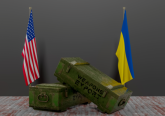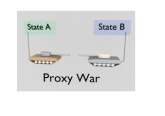Just over a year after Russia’s invasion of Ukraine in February 2022, Dr. Stefanie Babst, who has held several senior positions at NATO, including heading its Strategic Foresight Team from 2012 to 2020, has published her latest book, Sehenden Auges: Mut zum Strategischen Kurswechsel (With Eyes Wide Open: The Courage for a Strategic Course Change). The book is an important call for critical reflection and course correction among NATO partners and a plea for the West to continue to support Ukraine, not least in its own interests.
The first part of the book contextualises Russia’s war on Ukraine. The author explains Putin’s rise to power, the workings of his power apparatus, and Moscow’s strategic objectives. Babst provides the reader with the necessary background leading to today’s conflict and with a clear breakdown of Russia’s strategic objectives – the pursuit of a change in the international order, the attainment of great power status for Russia, and the creation of spheres of influence exclusive to Russia. Babst then turns to the mistakes that the West, and Germany in particular, has made in dealing with Russia over the past twenty years.
According to Babst, Germany’s main mistakes in its foreign policy towards Russia are (1) its nostalgically transfigured image of Russia (related to Willy Brandt’s Ostpolitik and East Germany’s shared history with Russia), which led German politicians to grant Russia comparatively more leniency and special treatment, (2) Germany’s economic interests in Russia and its dependence on Russian raw materials, (3) the belief that the Putin regime could be politically influenced through close personal contacts, (4) the failure to recognise the moment when the strategic partnership with Russia turned into a strategic antagonism, (5) the lack of attention paid to Russia’s increased activities in relevant regions in Africa, the Middle East, the Arctic, and outer space, and (6) the refusal to accept reality, even when it became abundantly clear that Moscow would attack Ukraine militarily.
By identifying six key factors, which are not mutually exclusive, Babst partly conflates the causes and consequences of Germany’s misjudgement of Russia. The first three factors – the nostalgic image of Russia, economic interests, and the belief in influencing Putin through personal contacts – clearly contribute to the failures of German foreign policy towards Russia. However, the last three factors –the failure to recognise Russia as a strategic adversary, its antagonistic activities in other world regions, and its military intentions in Ukraine – can also be seen as consequences of Germany’s misjudgement of Russia. Moreover, while all six of Babst’s points are valid in explaining Germany’s failed Russia policy, she does not assess their relative importance. In doing so, she also leaves the reader wondering whether Germany’s and other Western countries’ mistakes towards Russia can be attributed primarily to a lack of understanding on the part of politicians or to an active disregard of the warning signals. This is particularly interesting because, in her discussion of NATO’s failures vis-à-vis Russia, Babst suggests that knowledge of developments in Russia was detailed at the NATO level and refers to an analytical paper on Russia that her team wrote in the autumn of 2013 calling for a strategic rethink of the Alliance’s approach. Yet the basic political behaviour of NATO allies towards Russia did not change fundamentally between 2014 and Russia’s full-scale invasion of Ukraine in February 2023.
In the final section, Babst stresses the importance of ‘strategic foresight’ and outlines the way forward for NATO. In line with the goal of strategic foresight, which is to envision multiple futures and enable actors to anticipate change without predicting the likelihood of specific outcomes, the author presents three possible scenarios for the course of the war in Ukraine. One shortcoming, however, is that she does not detail the conditions under which they would materialise.
Babst’s main argument in the final section is that systematic action against Putin’s Russia requires political unity among the Western allies and a clear naming of ‘Putinism’ as an authoritarian regime that instils terror both internally and externally are essential. She offers seven comprehensible and well-considered suggestions for how the Western alliance could develop a strategy to roll back ‘Putinism.’ These include providing permanent support for Ukraine’s existential security, systematically curbing Russia’s means of implementing its foreign and military policy ambitions, and rethinking ways to strengthen NATO’s political coherence. However, this last point in particular lacks concrete proposals. While Babst alludes to rethinking NATO’s unanimity procedure and the need for a greater dose of realism and fearlessness, she provides no details on how such changes in organisation, strategic foresight capabilities and more importantly mindset could be achieved.
In conclusion, Babst’s book analyses the West’s misjudgements towards Russia and urges Western policymakers to engage in a more systematic process of reflection. Interspersed with personal anecdotes from Babst’s time in various senior NATO positions, it is an interesting read for anyone interested in better understanding the West’s failures with Russia, what course corrections are needed, and how such failures might be avoided with other authoritarian adversaries such as China and Iran.
With Eyes Wide Open: The Courage for a Strategic Course Change was first published in German. The title has been loosely translated into English. An English version is expected to follow.







